Karthik Narasimhan
Princeton University
IMPersona: Evaluating Individual Level LM Impersonation
Apr 08, 2025Abstract:As language models achieve increasingly human-like capabilities in conversational text generation, a critical question emerges: to what extent can these systems simulate the characteristics of specific individuals? To evaluate this, we introduce IMPersona, a framework for evaluating LMs at impersonating specific individuals' writing style and personal knowledge. Using supervised fine-tuning and a hierarchical memory-inspired retrieval system, we demonstrate that even modestly sized open-source models, such as Llama-3.1-8B-Instruct, can achieve impersonation abilities at concerning levels. In blind conversation experiments, participants (mis)identified our fine-tuned models with memory integration as human in 44.44% of interactions, compared to just 25.00% for the best prompting-based approach. We analyze these results to propose detection methods and defense strategies against such impersonation attempts. Our findings raise important questions about both the potential applications and risks of personalized language models, particularly regarding privacy, security, and the ethical deployment of such technologies in real-world contexts.
ShieldGemma 2: Robust and Tractable Image Content Moderation
Apr 01, 2025Abstract:We introduce ShieldGemma 2, a 4B parameter image content moderation model built on Gemma 3. This model provides robust safety risk predictions across the following key harm categories: Sexually Explicit, Violence \& Gore, and Dangerous Content for synthetic images (e.g. output of any image generation model) and natural images (e.g. any image input to a Vision-Language Model). We evaluated on both internal and external benchmarks to demonstrate state-of-the-art performance compared to LlavaGuard \citep{helff2024llavaguard}, GPT-4o mini \citep{hurst2024gpt}, and the base Gemma 3 model \citep{gemma_2025} based on our policies. Additionally, we present a novel adversarial data generation pipeline which enables a controlled, diverse, and robust image generation. ShieldGemma 2 provides an open image moderation tool to advance multimodal safety and responsible AI development.
LoRA Soups: Merging LoRAs for Practical Skill Composition Tasks
Oct 16, 2024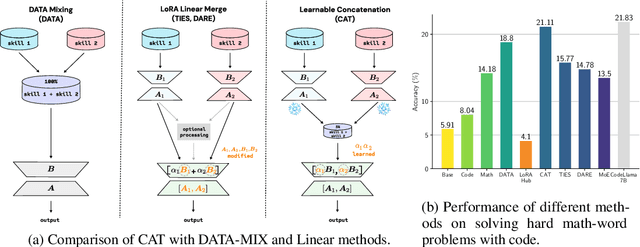

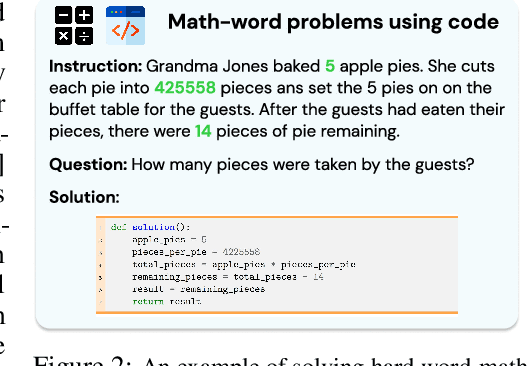

Abstract:Low-Rank Adaptation (LoRA) is a popular technique for parameter-efficient fine-tuning of Large Language Models (LLMs). We study how different LoRA modules can be merged to achieve skill composition -- testing the performance of the merged model on a target task that involves combining multiple skills, each skill coming from a single LoRA. This setup is favorable when it is difficult to obtain training data for the target task and when it can be decomposed into multiple skills. First, we identify practically occurring use-cases that can be studied under the realm of skill composition, e.g. solving hard math-word problems with code, creating a bot to answer questions on proprietary manuals or about domain-specialized corpora. Our main contribution is to show that concatenation of LoRAs (CAT), which optimally averages LoRAs that were individually trained on different skills, outperforms existing model- and data- merging techniques; for instance on math-word problems, CAT beats these methods by an average of 43% and 12% respectively. Thus, this paper advocates model merging as an efficient way to solve compositional tasks and underscores CAT as a simple, compute-friendly and effective procedure. To our knowledge, this is the first work demonstrating the superiority of model merging over data mixing for binary skill composition tasks.
An Annotated Dataset of Errors in Premodern Greek and Baselines for Detecting Them
Oct 14, 2024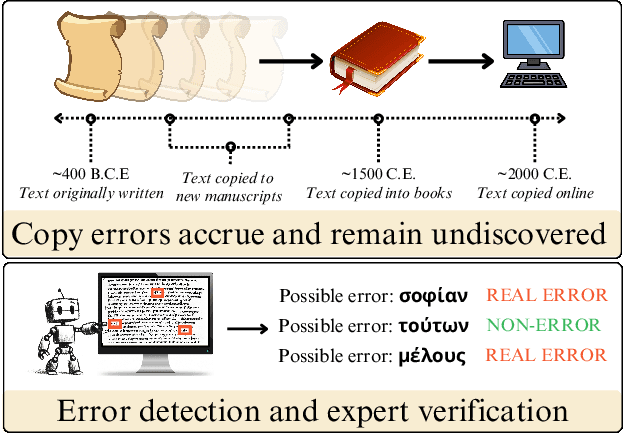

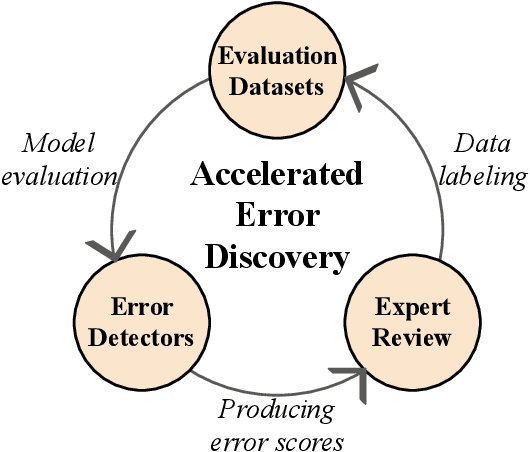
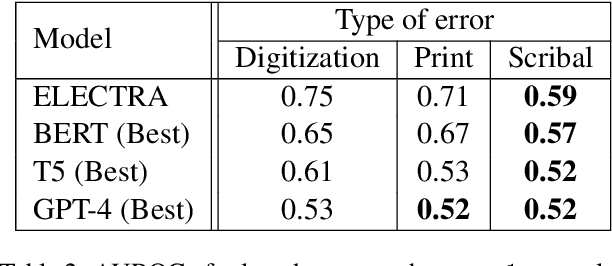
Abstract:As premodern texts are passed down over centuries, errors inevitably accrue. These errors can be challenging to identify, as some have survived undetected for so long precisely because they are so elusive. While prior work has evaluated error detection methods on artificially-generated errors, we introduce the first dataset of real errors in premodern Greek, enabling the evaluation of error detection methods on errors that genuinely accumulated at some stage in the centuries-long copying process. To create this dataset, we use metrics derived from BERT conditionals to sample 1,000 words more likely to contain errors, which are then annotated and labeled by a domain expert as errors or not. We then propose and evaluate new error detection methods and find that our discriminator-based detector outperforms all other methods, improving the true positive rate for classifying real errors by 5%. We additionally observe that scribal errors are more difficult to detect than print or digitization errors. Our dataset enables the evaluation of error detection methods on real errors in premodern texts for the first time, providing a benchmark for developing more effective error detection algorithms to assist scholars in restoring premodern works.
EnIGMA: Enhanced Interactive Generative Model Agent for CTF Challenges
Sep 24, 2024



Abstract:Although language model (LM) agents are demonstrating growing potential in many domains, their success in cybersecurity has been limited due to simplistic design and the lack of fundamental features for this domain. We present EnIGMA, an LM agent for autonomously solving Capture The Flag (CTF) challenges. EnIGMA introduces new Agent-Computer Interfaces (ACIs) to improve the success rate on CTF challenges. We establish the novel Interactive Agent Tool concept, which enables LM agents to run interactive command-line utilities essential for these challenges. Empirical analysis of EnIGMA on over 350 CTF challenges from three different benchmarks indicates that providing a robust set of new tools with demonstration of their usage helps the LM solve complex problems and achieves state-of-the-art results on the NYU CTF and Intercode-CTF benchmarks. Finally, we discuss insights on ACI design and agent behavior on cybersecurity tasks that highlight the need to adapt real-world tools for LM agents.
LLMs are Superior Feedback Providers: Bootstrapping Reasoning for Lie Detection with Self-Generated Feedback
Aug 25, 2024



Abstract:Large Language Models (LLMs) excel at generating human-like dialogues and comprehending text. However, understanding the subtleties of complex exchanges in language remains a challenge. We propose a bootstrapping framework that leverages self-generated feedback to enhance LLM reasoning capabilities for lie detection. The framework consists of three stages: suggestion, feedback collection, and modification. In the suggestion stage, a cost-effective language model generates initial predictions based on game state and dialogue. The feedback-collection stage involves a language model providing feedback on these predictions. In the modification stage, a more advanced language model refines the initial predictions using the auto-generated feedback. We investigate the application of the proposed framework for detecting betrayal and deception in Diplomacy games, and compare it with feedback from professional human players. The LLM-generated feedback exhibits superior quality and significantly enhances the performance of the model. Our approach achieves a 39% improvement over the zero-shot baseline in lying-F1 without the need for any training data, rivaling state-of-the-art supervised learning results.
ShieldGemma: Generative AI Content Moderation Based on Gemma
Jul 31, 2024
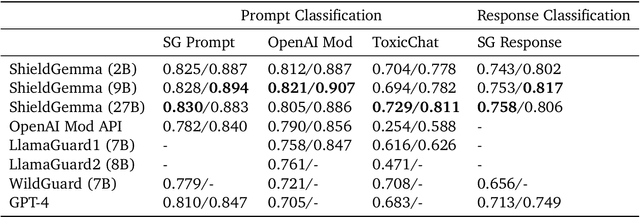

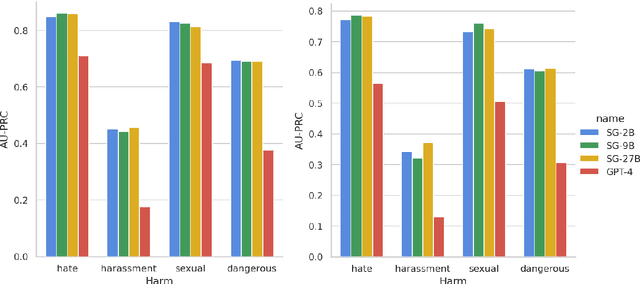
Abstract:We present ShieldGemma, a comprehensive suite of LLM-based safety content moderation models built upon Gemma2. These models provide robust, state-of-the-art predictions of safety risks across key harm types (sexually explicit, dangerous content, harassment, hate speech) in both user input and LLM-generated output. By evaluating on both public and internal benchmarks, we demonstrate superior performance compared to existing models, such as Llama Guard (+10.8\% AU-PRC on public benchmarks) and WildCard (+4.3\%). Additionally, we present a novel LLM-based data curation pipeline, adaptable to a variety of safety-related tasks and beyond. We have shown strong generalization performance for model trained mainly on synthetic data. By releasing ShieldGemma, we provide a valuable resource to the research community, advancing LLM safety and enabling the creation of more effective content moderation solutions for developers.
PersonaGym: Evaluating Persona Agents and LLMs
Jul 29, 2024Abstract:Persona agents, which are LLM agents that act according to an assigned persona, have demonstrated impressive contextual response capabilities across various applications. These persona agents offer significant enhancements across diverse sectors, such as education, healthcare, and entertainment, where model developers can align agent responses to different user requirements thereby broadening the scope of agent applications. However, evaluating persona agent performance is incredibly challenging due to the complexity of assessing persona adherence in free-form interactions across various environments that are relevant to each persona agent. We introduce PersonaGym, the first dynamic evaluation framework for assessing persona agents, and PersonaScore, the first automated human-aligned metric grounded in decision theory for comprehensive large-scale evaluation of persona agents. Our evaluation of 6 open and closed-source LLMs, using a benchmark encompassing 200 personas and 10,000 questions, reveals significant opportunities for advancement in persona agent capabilities across state-of-the-art models. For example, Claude 3.5 Sonnet only has a 2.97% relative improvement in PersonaScore than GPT 3.5 despite being a much more advanced model. Importantly, we find that increased model size and complexity do not necessarily imply enhanced persona agent capabilities thereby highlighting the pressing need for algorithmic and architectural invention towards faithful and performant persona agents.
$τ$-bench: A Benchmark for Tool-Agent-User Interaction in Real-World Domains
Jun 17, 2024Abstract:Existing benchmarks do not test language agents on their interaction with human users or ability to follow domain-specific rules, both of which are vital for deploying them in real world applications. We propose $\tau$-bench, a benchmark emulating dynamic conversations between a user (simulated by language models) and a language agent provided with domain-specific API tools and policy guidelines. We employ an efficient and faithful evaluation process that compares the database state at the end of a conversation with the annotated goal state. We also propose a new metric (pass^k) to evaluate the reliability of agent behavior over multiple trials. Our experiments show that even state-of-the-art function calling agents (like gpt-4o) succeed on <50% of the tasks, and are quite inconsistent (pass^8 <25% in retail). Our findings point to the need for methods that can improve the ability of agents to act consistently and follow rules reliably.
Can Language Models Solve Olympiad Programming?
Apr 16, 2024Abstract:Computing olympiads contain some of the most challenging problems for humans, requiring complex algorithmic reasoning, puzzle solving, in addition to generating efficient code. However, it has been understudied as a domain to evaluate language models (LMs). In this paper, we introduce the USACO benchmark with 307 problems from the USA Computing Olympiad, along with high-quality unit tests, reference code, and official analyses for each problem. These resources enable us to construct and test a range of LM inference methods for competitive programming for the first time. We find GPT-4 only achieves a 8.7% pass@1 accuracy with zero-shot chain-of-thought prompting, and our best inference method improves it to 20.2% using a combination of self-reflection and retrieval over episodic knowledge. However, this is far from solving the benchmark. To better understand the remaining challenges, we design a novel human-in-the-loop study and surprisingly find that a small number of targeted hints enable GPT-4 to solve 13 out of 15 problems previously unsolvable by any model and method. Our benchmark, baseline methods, quantitative results, and qualitative analysis serve as an initial step toward LMs with grounded, creative, and algorithmic reasoning.
 Add to Chrome
Add to Chrome Add to Firefox
Add to Firefox Add to Edge
Add to Edge